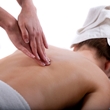Deep tissue massage
Deep tissue massage
Natural Standard Monograph, Copyright © 2013 (www.naturalstandard.com). Commercial distribution prohibited. This monograph is intended for informational purposes only, and should not be interpreted as specific medical advice. You should consult with a qualified healthcare provider before making decisions about therapies and/or health conditions.
Related Terms
Massage, Swedish massage.
For an overview of massage, please see the massage monograph in the Complementary Practices Database.
Background
Deep tissue massage is a massage technique that focuses on the deeper layers of muscle tissue. It aims to release the chronic patterns of tension in the body through slow strokes and deep finger pressure on the contracted areas, either following or going across the fiber's of the muscles, tendons and fascia.
Deep tissue massage uses many of the same movements and techniques as Swedish massage, a more superficial massage, but the pressure will generally be more intense.
This type of massage is often used to treat chronic pain, limited mobility, recovery from injuries (e.g. whiplash, falls, sports injury), repetitive strain injury, such as carpal tunnel syndrome, postural problems, osteoarthritis pain, fibromyalgia, and muscle tension or spasm.
Theory/Evidence
It is thought that when muscles are stressed, they block oxygen and nutrients, leading to inflammation that builds up toxins in the muscle tissue.
A deep tissue massage may help loosen muscle tissues, release toxins from muscles and get blood and oxygen circulating properly. Because many toxins are released, it is recommended to drink plenty of water after a deep tissue session to help eliminate these toxins from the body.
According to the August 2005 issue of Consumer Reports magazine, 34,000 people ranked deep tissue massage more effective in relieving osteoarthritis pain than physical therapy, exercise, prescription medications, chiropractic, acupuncture, diet, glucosamine and over-the-counter drugs.
Precautions/Contraindications
Use cautiously in those with infectious skin disease, rash, or open wounds; immediately after surgery; immediately after chemotherapy or radiation, unless recommended by a doctor; in those with osteoporosis; in those prone to blood clots; or if pregnant.
Massage should not be done directly over bruises, inflamed skin, unhealed wounds, tumors, abdominal hernia or areas of recent fractures.
Safety
People may feel sore for one to two days after deep tissue massage, but it will subside within a day or two if massage is done correctly.
Displacement of a ureteral stent and a hepatic hematoma after deep tissue massage were reported in one case report. Based on another case report, posterior interosseous syndrome has resulted from deep tissue massage.
Despite these scattered reports of adverse experiences, common forms of massage (e.g., Swedish, deep tissue, and neuromuscular) are considered very low risk, especially when massage is tailored appropriately to the individual.
Author Information
This information has been edited and peer-reviewed by contributors to the Natural Standard Research Collaboration (www.naturalstandard.com).
Bibliography
Natural Standard developed the above evidence-based information based on a thorough systematic review of the available scientific articles. For comprehensive information about alternative and complementary therapies on the professional level, go to www.naturalstandard.com. Selected references are listed below.
Braverman DL, Schulman RA. Massage techniques in rehabilitation medicine. Phys Med Rehabil Clin N Am. 1999;10:631-649. View Abstract
Giese S, Hentz VR. Posterior interosseous syndrome resulting from deep tissue massage. Plast Reconstr Surg. 1998 Oct;102(5):1778-9. View Abstract
Sherman K, Cherkin D, Kahn J, Erro J, Hrbek A, Deyo R, Eisenberg D. A survey of training and practice patterns of massage therapists in two US states. BMC Complement Altern Med. 2005 Jun 14;5:13. View Abstract
Trotter JF. Hepatic hematoma after deep tissue massage. N Engl J Med. 1999;341:2019-2020. View Abstract
Wong C. Deep Tissue Massage. 11 May 2006. http://altmedicine.about.com/od/massage/a/massage.htm
Copyright © 2013 Natural Standard (www.naturalstandard.com)
The information in this monograph is intended for informational purposes only, and is meant to help users better understand health concerns. Information is based on review of scientific research data, historical practice patterns, and clinical experience. This information should not be interpreted as specific medical advice. Users should consult with a qualified healthcare provider for specific questions regarding therapies, diagnosis and/or health conditions, prior to making therapeutic decisions.
Updated:
March 22, 2017
